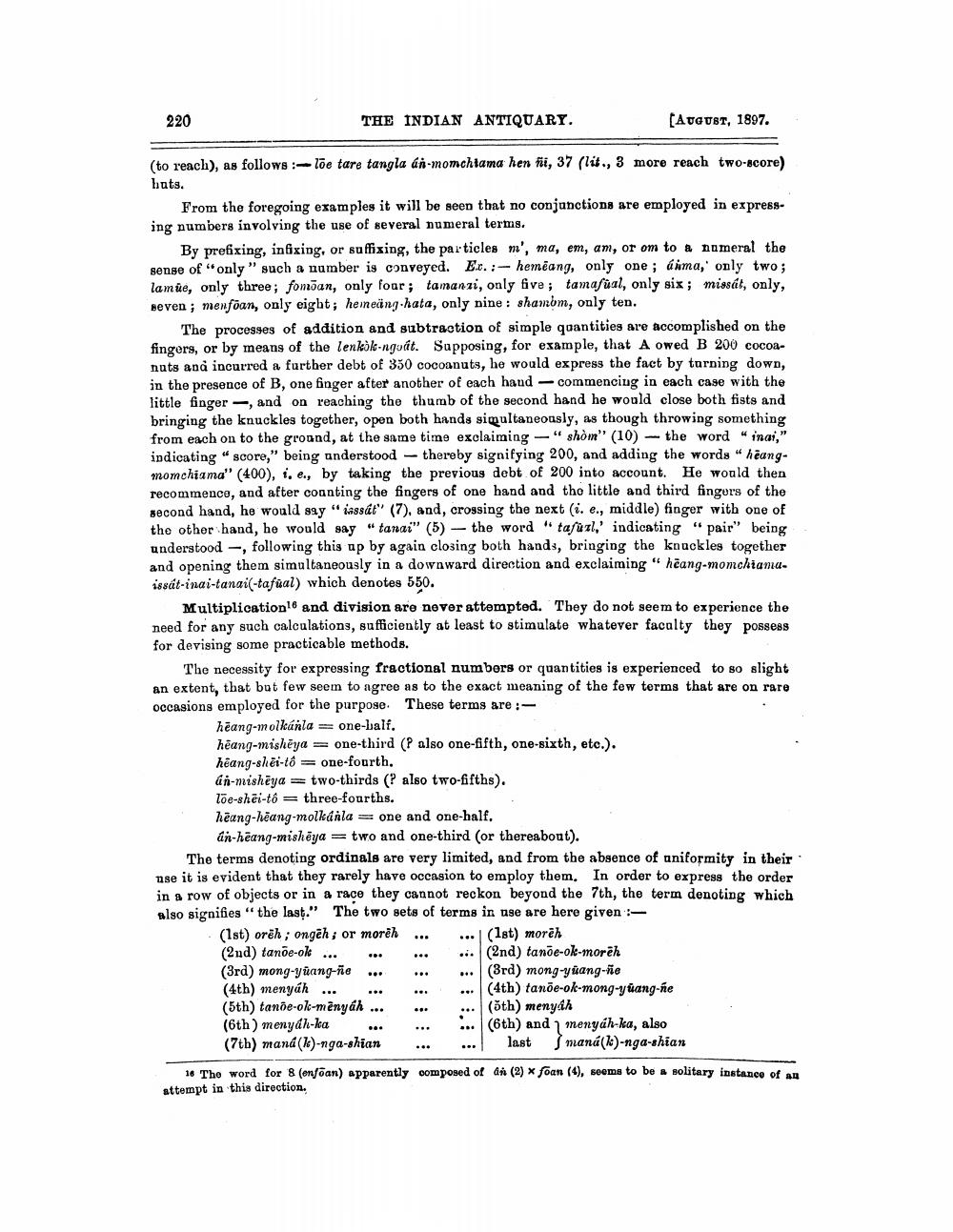________________
220
THE INDIAN ANTIQUARY.
(AUGUST, 1897.
(to reach), as follows:- loe tare tangla án-momchtama hen fii, 37 (lit., 3 more reach two-score)
huts.
From the foregoing examples it will be seen that no conjunctions are employed in expressing numbers involving the use of several numeral terms.
By prefixing, infixing, or suffixing, the particles m', ma, em, am, or om to a numeral the sense of "only " such a number is conveyed. Ec. :- hemēang, only one; bima,' only two; lamüe, only three; fomban, only four; tamanzi, only five; tamafüal, only six; missát, only, seven; menfoan, only eight; hemeäng.hata, only nine: shamom, only ten.
The processes of addition and subtraction of simple quantities are accomplished on the fingers, or by means of the lenkòk-ngoat. Supposing, for example, that A owed B 200 cocoanuts and incurred a further debt of 350 cocoanuts, he would express the fact by turning down, in the presence of B, one finger after another of each haud - commencing in each case with the little finger , and on reaching the thumb of the second hand he would close both fists and bringing the knuckles together, open both hands simultaneously, as though throwing something from each on to the ground, at the same time exclaiming "shom" (10) - the word "inai," indicating score," being understood thereby signifying 200, and adding the words "heangmomchiama" (400), i, e., by taking the previous debt of 200 into account. He would then recommence, and after counting the fingers of one hand and the little and third fingers of the second hand, he would say "sssát" (7), and, crossing the next i. e., middle) finger with one of the other hand, he would say "tanai" (5) - the word "tafuzl,' indicating "pair" being understood -, following this ap by again closing both hands, bringing the knuckles together and opening them simultaneously in a downward direction and exclaiming "heang-momchiama. issát-inai-tanais-tafual) which denotes 550.
Multiplication and division are never attempted. They do not seem to experience the need for any such calculations, sufficiently at least to stimulate whatever faculty they possess for devising some practicable methods.
The necessity for expressing fractional numbers or quantities is experienced to so slight an extent, that but few seem to agree as to the exact meaning of the few terms that are on rare occasions employed for the purpose. These terms are:
heang-molkánla = one-half. heang-mishēya = one-third (P also one-fifth, one-sixth, etc.). heang-s@i-tô = one-fourth. ár-mishĒya = two-thirds (? also two-fifths). loe-shēi-tô = three-fourths. heang-hoang-molkanla = one and one-half.
an-heang-mishöya two and one-third (or thereabout). The terms denoting ordinals are very limited, and from the absence of uniformity in their use it is evident that they rarely have occasion to employ them. In order to express the order in a row of objects or in a race they cannot reckon beyond the 7th, the term denoting which also signifies the last." The two sets of terms in use are here given :
(1st) orëh; ongeh; or morëh ... ... (1st) morëh (2nd) tanõe-ok ... ...
... (2nd) tanõe-ok-moreh (3rd) mong-yuang-tie ...
(3rd) mong-yang-ñe (4th) menyáh ... ...
(4th) tanõe-ok-mong-yuang-ne (5th) tanõe-ok-menyah ...
...(õth) menyah (6th) menyák-ka
(6th) and menyáh-ka, also (7th) maná (1)-nga-shian ... ... last S maná(l)-nga-shian
16 The word for 8 (onfoan) apparently composed of ds (2) * Foan (4), seems to be solitary instance of an attempt in this direction,




